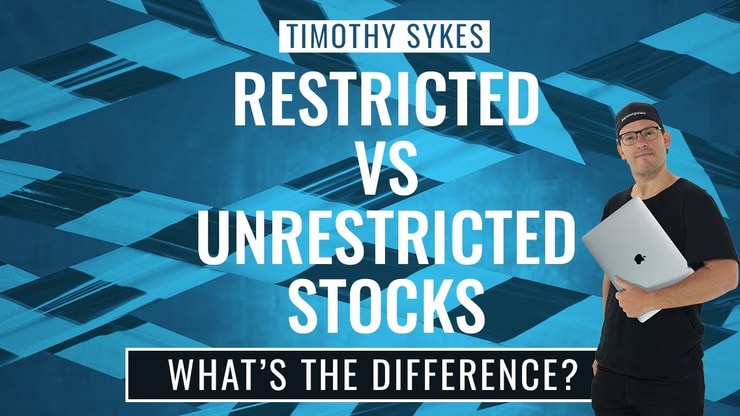What’s the difference between outstanding shares, issued shares, and float?
The numbers of these shares can vary widely…
And that can have a huge impact on how the stock trades and its volatility. The numbers can also change over time.
But shares outstanding can tell you important information about the number of shares that a company can possibly sell into the market. That’s why it’s important to know the difference and what’s included in these numbers.
How’s it all calculated and what number matters most to traders?
I’ll break it all down for you in this post … Let’s do this!
Table of Contents

Outstanding shares are the total number of a company’s shares. It includes shares held by insiders, institutions, regular investors, and the shares that get freely traded each day.
But it’s not a fixed number. It can change if the company does a forward or reverse stock split, a share buyback, secondary offering, or financing.
Penny stock companies can have hundreds of millions or even billions of shares outstanding.
When a company creates more shares, those shares become part of the shares outstanding. And it dilutes the value of existing shares. It means the company’s value is spread over more shares.
Penny stock companies usually create more shares and dilute shareholders through toxic financings. They sell millions of shares at a deep discount to raise capital for research, development, expansion, or — because I always think the worst of every company — to line insiders’ pockets.
They can also give shares to promoters to pump the stock. Then, once the stock goes full supernova, the insiders and promoters can sell their shares for a nice profit. That’s all at the expense of newbies who believe in the company and invest in it long term.
That’s why I don’t believe in any of these companies.
And I hate to see new traders and uneducated investors fall for the hype … I was one of them once…
Years ago, I believed in a penny stock company and I lost $500,000 of my own money. You can read all about it and the lesson I learned in my no-cost book “An American Hedge Fund.”
So I became a teacher to educate traders about the penny stock game…
Promotions and dilution are why so many people love to hate penny stocks. But if you know how the game works, you can take advantage of the volatile moves. I teach my students how to do that in my Trading Challenge.
Want to learn more about the niche I’ve traded to make over $7.1 million in profits?* Start with my FREE guide to trading penny stocks.
What’s the difference between outstanding shares vs. float? Or issued shares vs. outstanding shares?
Here’s a breakdown of the different types of share calculations…
Outstanding shares are the total number of shares created by the company. It includes restricted shares and blocks of shares held by institutions and insiders that may not be traded as part of the public float.
It doesn’t include treasury shares. More on what those are shortly…
The number of issued shares includes treasury shares and other shares the company holds. These can be shares that are part of a shelf offering or shares the company holds for employees as part of their employment benefits.
Treasury shares are shares a company holds that it bought through a stock buyback. The company can sell treasury shares back into the market if it needs cash or if it wants to make a profit by selling them for more than it paid.
Floating Stock
A stock’s float is the most important number for traders. These are the shares that freely trade each day. It doesn’t include institutional holdings, restricted shares, or insiders’ shares.
Like the number of outstanding shares, the float can change. As restricted shares become unrestricted, insiders can sell them into the market for a profit. Then they become part of the float.
If a company does financing, that creates more shares outstanding. And if the company that buys the shares for a deep discount turns around and sells them into the market, those also become part of the float.
That’s why offerings and dilution through toxic financing can have such a huge impact on a stock’s price. When the float becomes larger as these shares enter the market, each share becomes worth less. And it takes more demand to drive a stock’s price higher.
Market Cap
Market cap is a company’s value based on the share price and the number of shares outstanding.
This number is also fluid. It changes every day along with the stock’s price. It will also change if the number of shares changes through an offering or stock buyback.
You can use this simple outstanding shares formula to calculate the number of a company’s shares…
The company’s market cap divided by the current share price equals shares outstanding.
Outstanding shares are the number of shares used to determine a company’s market cap and its earnings per share (EPS). EPS is more important for investors than traders. Since I only hold my positions for a few minutes or hours, I don’t care about a company’s earnings or any of its financials.
To learn more about day trading penny stocks, get my 30-Day Bootcamp to jumpstart your education. It’s a month’s worth of lessons with daily assignments and homework. You can work at your own pace and repeat it as many times as you like.
Bonus: It comes with “The Complete Penny Stock Course” book and my “Pennystocking Framework” DVD (a $797 value). You get all three for under $100.
A company discloses its outstanding shares on its balance sheet as capital stock and in its quarterly reports. But you can also find it on websites or your trading platform.
StocksToTrade shows the number of outstanding shares and the float in the ‘Basics’ box. Right now you can get a 14-day trial of StockToTrade for only $7. Or grab it with the Breaking News Chat for $17.**
The Breaking News Chat is run by two former Wall Street pros. They sift through news and can alert you to important news that can impact a company’s number of shares outstanding — like offerings or splits. And that can help you make quick trading decisions.
It’s important to have the right trading tools — that’s why I think every trader should use StockToTrade.
But if you’re not using it yet, you can find a company’s outstanding shares on Yahoo Finance under the ‘Statistics’ tab. Or you can look at a stock’s information table below the chart on finviz.com.
If a company did a recent forward or reverse split, the information online might not be accurate. You can calculate the new number of shares based on the split ratio.
And if there’s a huge difference between the number of shares in the float and the number of outstanding shares, it can mean more shares could enter the market. If restricted shares become unrestricted, those can all potentially be sold into the market to unsuspecting traders.
That’s why I always trade scared. I expect the worst out of every company so I’m never disappointed.

All publicly traded companies have outstanding shares. It doesn’t mean a company has shares out there laying around or missing.
But the number of shares outstanding can be considered good or bad … The more shares a company has, the more the value of the company is spread out. That could be considered bad because each share is worth less of the company.
The fewer shares there are, the more each share is worth of the company.
But since the number of shares outstanding includes shares that won’t be traded every day, day traders should be more concerned about the company’s float.
Stocks with a low float tend to be more volatile since there are fewer shares to go around. When high volume comes in due to a news catalyst or promotion, it can create massive moves and short squeezes.
And we’ve seen a ton of low float short squeezes in the market recently. Reddit and chat room traders target low float stocks with a high short interest specifically to create giant squeezes.
It’s the cause of some of the most insane penny stock runners. Stocks that go from $5 to $50 in a few hours aren’t unheard of lately.
But those volatile stocks can also drop just as quickly. That’s why rule #1 is to cut losses quickly.
Too many new traders hold and hope a stock will go back up. They don’t know that most penny stocks fail. They believe the penny stock promoters who tell them to hold through dips or that it’s not a loss unless they sell…
And sadly, that’s why the majority of traders lose.
Trading Challenge
Too many traders don’t have a trading education or prepare trading plans in advance. They blindly follow others and buy hot stock picks. And they’re left holding a loser when the hype fades.
That’s why I teach students in my Trading Challenge how to become self-sufficient traders. I don’t want anyone to follow my trade alerts or picks. I want you to learn the thought process behind my trade ideas. That way, over time, you can learn to develop your own.
It doesn’t happen overnight — but it’s possible over time. Most of my millionaire students have been in my Challenge for a few years.* It takes time to learn the nuances of the market. It ebbs and flows. And you must learn to adapt to it.
Ready to think for yourself and navigate any kind of market? Apply for my Trading Challenge now! But only if you’re up for hard work.
Want to learn more? Here are some key FAQs…
Penny stock companies probably have more shares outstanding than any other company. Sometimes these companies can have billions of shares outstanding because they dilute shares to raise capital through financings.
You can find a company’s historical shares outstanding online. It can help you see if insiders are selling when their shares become unrestricted or if they’re holding. And that can tell you a lot about a company’s potential success.
The history of shares outstanding for Fastly, Inc. (NYSE: FSLY) over two years is a good example of how widely the numbers can change. The company had roughly 24 million shares outstanding in 2018 and 104 million in 2020.

All publicly traded companies have outstanding shares. It’s not good or bad. It’s just part of doing business.
As a day trader, I like to take advantage of volatility. So to me, the fewer the shares, the better. That means the stock has more potential for huge price swings. But volume and float are relative. A stock with a lot of shares can still have big moves with high volume.
But it’s important to look at the number of outstanding shares to know how many more shares could possibly enter the market. Company insiders could sell their shares as they become unrestricted.
That’s why I always trade scared. I only hold my positions for a short time — sometimes only a few minutes. But I’ve still grown my account to over $7.1 million in trading profits.*
My goal is to take the meat of the move, then move on. I don’t hold and hope and I don’t invest.
If you want to learn the process, patterns, and mindset I use, apply for my Trading Challenge today.
Did this post help you understand more about outstanding shares? Let me know in the comments … I love to hear from you!
Disclaimers
*Please note that reported trading results are not typical. Most traders lose money. It takes years of dedication, hard work, and discipline to learn how to trade. Individual results will vary. Trading is inherently risky. Before making any trades, remember to do your due diligence and never risk more than you can afford to lose.
While Tim Sykes has enjoyed remarkable success trading stocks over the years, his primary income derives from the sale of financial education products and subscription services offered by various businesses and websites in which he has an ownership stake.
**Tim Sykes has a minority ownership stake in StockstoTrade.com.









Leave a reply